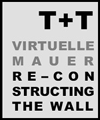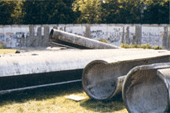
A "storyboard" is a typical planning aid for a film, a linear series of sketches depicting the order in which events are to be depicted. In an interactive 3D work, however, it may be impossible to specify the exact order of events, as they are to a large extent triggered or determined by the actions of the users. Therefore the dramatic concept is not depicted in a linear storyboard, but rather in a "hyper-storyboard," a multi-dimensional depiction of scenes and the potential paths between scenes.
For example, if a single scene contains several "portals," each leading to a different subsequent scene, or contains "hotspots," each triggering different events, it is up to the users themselves to decide - knowingly or unknowingly - which of these portals or hotspots to engage first. The author of the hyper-storyboard creates the web of possible scenes and their connections, and makes sure that each possible sequence of events produces a convincing and engaging dramatic experience for the user.
In contrast to a traditional film or linear story, therefore, there is no inevitable outcome or single grand climax that provides a dramatic catharsis for the users. Instead, drama in an interactive VR artwork comes from the dramatic arcs that arise as the users test the boundaries of determinism and free will in their interactions with the virtual world, and in the sense of responsibility and emotional engagement that results when users realize that they are encountering the results of their own actions.
| Home |
| Introduction |
| Site |
| > Development |
| Presentation |
| Documentation |
| Artist Team T+T |
| Supporters |
| Berlin Wall Links |
| Events |

[ Research ] [ Dramatic Concept ] [ Hyper-Storyboard ] [ VR Production ]